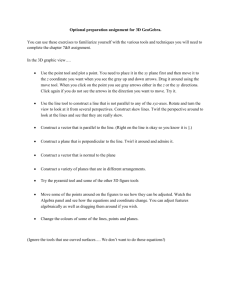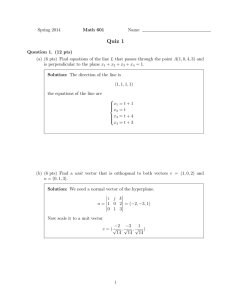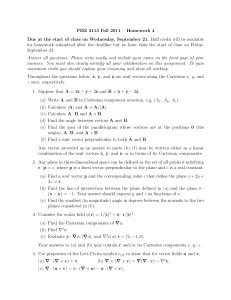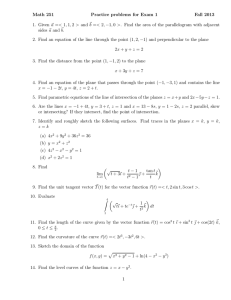www.studyguide.pk Section 4 of Unit 03 (Pure Mathematics 3)
advertisement
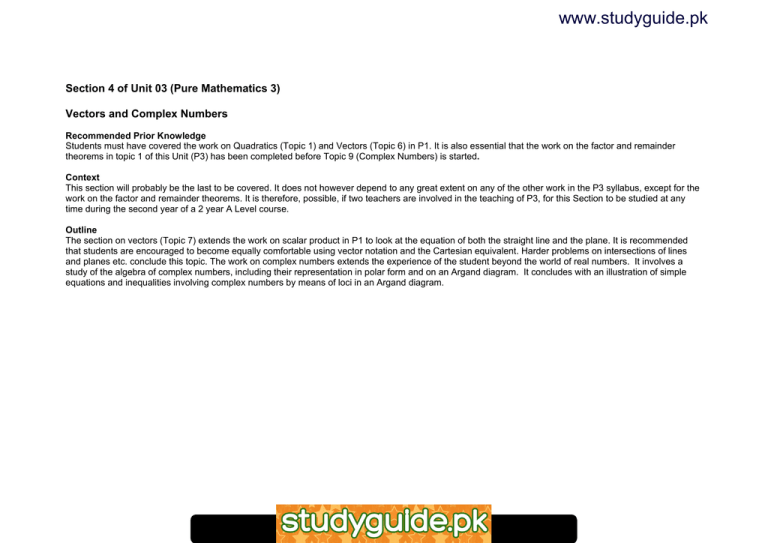
www.studyguide.pk Section 4 of Unit 03 (Pure Mathematics 3) Vectors and Complex Numbers Recommended Prior Knowledge Students must have covered the work on Quadratics (Topic 1) and Vectors (Topic 6) in P1. It is also essential that the work on the factor and remainder theorems in topic 1 of this Unit (P3) has been completed before Topic 9 (Complex Numbers) is started. Context This section will probably be the last to be covered. It does not however depend to any great extent on any of the other work in the P3 syllabus, except for the work on the factor and remainder theorems. It is therefore, possible, if two teachers are involved in the teaching of P3, for this Section to be studied at any time during the second year of a 2 year A Level course. Outline The section on vectors (Topic 7) extends the work on scalar product in P1 to look at the equation of both the straight line and the plane. It is recommended that students are encouraged to become equally comfortable using vector notation and the Cartesian equivalent. Harder problems on intersections of lines and planes etc. conclude this topic. The work on complex numbers extends the experience of the student beyond the world of real numbers. It involves a study of the algebra of complex numbers, including their representation in polar form and on an Argand diagram. It concludes with an illustration of simple equations and inequalities involving complex numbers by means of loci in an Argand diagram. www.xtremepapers.net www.studyguide.pk Topic 7 Learning Outcomes Suggested Teaching Activities Vectors It is advisable to revise all the work on vectors in Topic 6 of P1, particularly on the calculation of scalar product. • Suggest to the students that they draw sketches to illustrate, for given a and b, the position of the points represented by r = a + b, r = a + 2b, r = a + ½b and r = a − b. Discuss the significance of the equation r = a + tb. Students should be able to appreciate that this is the equation of a straight line, passing through A where OA=a in the direction parallel to the vector b where OB = b. They should recognise that t = 0 represents the point A, that t = 1 represents the point C where OC= a+b and that t = ½ represents the midpoint of AC. Students should be able to write the equation of the line joining (1, 2, 3) to (4, 1, 5) as r = (i+2j+3k) + t(3i−j+2k). Students should be able to determine whether a point, say (10,1,9), lies on this line by checking whether there is a single value of t which leads to r = 10i + j + 9k (in this case, t = 3 is the value of t that fits with the coefficients of both i and k but not with the coefficient of j). Understand the significance of all the symbols used when the equation of a straight line is expressed in the form r = a + tb. www.xtremepapers.net Resources Have an OHP available showing the line r = a + tb. This OHP should show the significance of all the symbols used in the equation. On-Line Resources www.studyguide.pk • Determine whether two lines are parallel, intersect or are skew. Discuss generally with the class the topic of two lines in space. Using two rulers, point out that there are three situations that can occur; either the lines are parallel, or skew or they intersect. Students should be able to recognise that the equation r = (i+2j+3k) + t(3i−j+2k) represents a line passing through (1,2,3) parallel to the vector 3i−j+2k. They should also appreciate that a general point on the line has coordinates (1+3t, 2−t, 3+2t). If a second line has equation, say r = (3i-2j+k) + s(3i+j-k), then the general point on this line is (3+3s, −2+s, 1−s) . By equating each of the x, y and z components for the two lines, three simultaneous equations are obtained for s and t. If all three equations lead to a unique value for s and t, then the lines meet. If the values of s and t obtained from two of the equations are unique, but do not satisfy the third equation, then the lines are skew. If the values of s and t obtained from the two equations are not unique then the equations are either inconsistent ( s = kt + c1 , s = kt + c2 where c1≠c2), in which case the lines are skew or parallel, or each is reducible to the same equation (say s=kt+c), in which case combining with the third can lead to unique values of s and t (lines meet), or inconsistent equations s = kt + c and s = kt + c3 , (lines OHP to show the possible situations that can occur with lines in space. The OHP could take the form of a flow chart for deciding the relationship between r=a+tb and r=c+sd. First decision “Is b=d?” the chart would then lead students through all the possibilities. skew or parallel) or the single equation s=kt+c, (lines identical). If the lines are parallel they have the same direction vector. • Find the angle between two lines and the point of intersection of two lines when it exists. Students should be able to work comfortably with the equations of two lines and determine whether they intersect, are parallel or are skew. If they do intersect, they should be able to use the value of s or t to find the coordinates of the point of intersection and use the scalar product of the direction vectors of the lines to find the angle between the two lines. www.xtremepapers.net OHP showing this calculation in full. www.studyguide.pk Students should also appreciate that the Cartesian equation of a line in three dimensions is given by x−a y−b z −c = = = λ and that this line passes through p q r the point (a,b,c) , is parallel to the vector pi + qr +rk and has a general point of (a+pλ,, b+qλ, c+rλ). • Understand the significance of all the symbols used when the equation of a plane is expressed in either of the forms ax + by + cz = d or (r – a).n =0. Students should realise that the vector equation (r – a).n =0 represents a plane passing through the point r = a such that the perpendicular to the plane is parallel to the vector n. They should also realise that in Cartesian coordinates, the equation ax + by + cz = d represents a plane such that the perpendicular to the plane is parallel to the vector ai+bj+ck and the distance of the plane from the origin (0,0) is d a2 + b2 + c2 OHP illustrating the significance of the symbols used in expressing the equation of a plane as (r – a).n =0 or ax + by + cz = d . . The students should be able to transfer from the Cartesian form of the equation of a plane to the vector form and vice versa and be equally comfortable with working in either form. • Use equations of lines and planes to solve problems concerning distances, angles and intersections, and in particular find the equation of a line or plane, given sufficient information Students should be able to use the information covered so far in this topic to solve problems linked with distances angles and intersections. They should be able to find the equation of planes and lines from information given. www.xtremepapers.net OHP giving the full solution to some of the more difficult questions on this topic. www.studyguide.pk 9 • determine whether a line lies in a plane, is parallel to a plane, or intersects a plane, and find the point of intersection of a line and a plane when it exists They should be able to determine whether a line is parallel to a plane, or whether it intersects the plane. There are several different methods for the latter – though the method of expressing the coordinates of the general point on a line in terms of one variable and then substituting these into the equation of the plane is probably the one which presents students with least problems. Students should be aware that this method is particularly useful if the point of intersection is also required. • find the line of intersection of two non-parallel planes • find the angle between two planes, and the angle between a line and a plane It is suggested that the students obtain as much practice as possible with different problems, realising that there are different methods of approach and finding those that relate most readily to a particular problem. This is not an easy topic either for the student to understand or for the teacher to get across. Encountering many different problems is by far the best experience for the students. Complex Numbers • Understand the idea of a complex number, recall the meaning of the terms real part, imaginary part, modulus, argument, conjugate, and use the fact that two complex numbers are equal if and only if both real and imaginary parts are equal. It is worth starting this topic by looking at the solution of a quadratic equation such as x 2 + 2 x + 5 = 0 . Students will realise that, for such an equation, b 2 − 4ac <0 and that the equation has no real roots. Introducing the theoretical idea of i = − 1 should lead the students to roots of 1 + 2i and 1 − 2i. Students will have difficulty appreciating that this topic extends the idea of number beyond “real numbers”.. At this stage it is sufficient to point out that many problems in engineering and in higher mathematics can only be solved by use of complex numbers. Students should be able to recall that for a complex number, say 3 + 5i, the real part is “3”, the imaginary part is “5” and that the complex conjugate is the complex number 3 − 5i. www.xtremepapers.net OHP showing the application of the formula to a quadratic for which b 2 − 4ac <0. www.studyguide.pk • Represent complex numbers geometrically by means of an Argand diagram. Students should be shown that 3 + 5i can be represented on Cartesian axes as the point P(3,5) and that the modulus is defined as the distance OP. The angle that OP makes with the positive x-axis is known as the argument (or amplitude). Students should be shown, by reference to the Argand diagram, that two complex numbers are equal if and only if both real and imaginary parts are equal. Students should realise that, in general, equating two complex numbers, leads to two simultaneous equations of real numbers. OHP showing (i) an Argand diagram for different complex numbers (ii) an Argand diagram showing equal complex numbers. • Carry out operations of addition, subtraction, multiplication and division of two complex numbers expressed in Cartesian form x + iy, Students should be encouraged to add, subtract and multiply two complex numbers and to realise, in each case, that a third complex number is obtained. They should be shown that division of, say, (2 + 4i) by (3 − 4i) is carried out by multiplying both the numerator and the denominator by the complex conjugate (3+4i). It should be emphasised that this process results in a complex number of the form a+ib. Students should be given lots of practice in these four basic operations. OHP showing the four processes, +,−,×,÷ applied to two complex numbers. • Find the two square roots of a complex number. Students should be able to find the square root of a complex number, say 5 + 12i, by firstly equating it to a + ib and then squaring both sides. The resulting complex equation leads to the real simultaneous equations, a 2 − b 2 = 5 and 2ab = 12 and hence to the values of a and b. Students should be aware that, as with real numbers, square roots occur in pairs (of the form c±id). • Use the result that, for a polynomial equation with real coefficients, any real roots occur in conjugate pairs. By examination of the roots of a quadratic equation with real coefficients, students should appreciate that the root a + ib will always occur alongside the root a − ib. Examination of the graph of a cubic equation should show that there are exactly 3 real roots or exactly 1 real root. Students should be able to use the factor theorem to deduce that if there is only one real root, then there is a quadratic equation with real coefficients for the other two roots and again they must occur as a ± ib. www.xtremepapers.net OHP showing possible graphs of cubic polynomials – having either 1 real or 3 real roots (or 2 repeated roots). www.studyguide.pk • Carry out operations of multiplication and division of two complex numbers expressed in polar form r (cosθ + i sin θ ) ≡ reiθ . Students should realise that any complex number, say 3 + 4i, can be written as r(cosθ + isinθ) where r is the modulus (=5) and θ is the argument (tan-1 4/3). Students should be encouraged to express complex numbers in polar form and to realise how multiplication of two complex numbers can be done directly with the resulting modulus being the product of the original moduli and the resulting argument being the sum of the original arguments. Similar results follow for the division of one complex number by another. Again, students will need plenty of practice with these operations. • Understand in simple terms the geometrical effects of conjugating a complex number and of adding, subtracting, multiplying and dividing two complex numbers. By drawing accurate Argand diagrams, students should appreciate that the complex conjugate of z is the reflection of z in the x-axis and be able to see the “vector” effect of either adding or subtracting two complex numbers. By expressing two complex numbers in polar form, students should realise the geometrical effect (enlargement and rotation) of multiplying or dividing two complex numbers. OHP showing the geometrical effect of the conjugate of a complex number, and the geometrical effect of the four basic operations of +,−,×,÷. • Illustrate simple equations and inequalities involving complex numbers by means of loci in an Argand diagram, e.g. z − a < k , Students should be encouraged to draw sketch graphs to appreciate fully the geometrical effects of the following statements. z = 4 → circle centre (0,0) , radius 4 It is advisable to have a large number of diagrams ready on OHP or power-point Illustrating a wide range of equations and inequalities involving complex numbers by means of loci in an Argand diagram. z − a = z − b , arg( z − a ) = α . z < 4 → region inside the circle centre (0,0), radius 4 z − a < k → region inside circle, centre (a,0), radius k arg(z) = ⅓π → line through (0,0) at ⅓π to +ve x-axis arg(z) < ⅓π → region between the lines y=⅓πx and y=0. Lots of practice with other more complicated examples. www.xtremepapers.net

